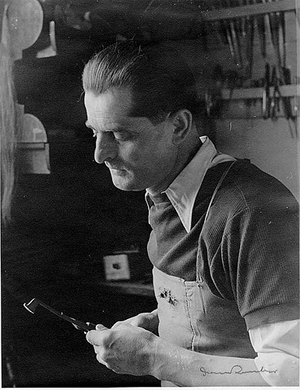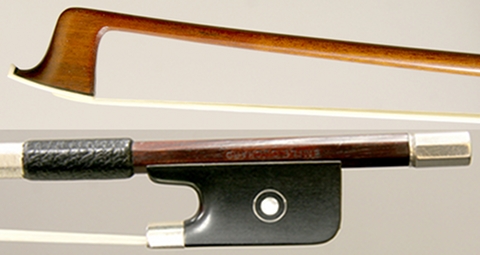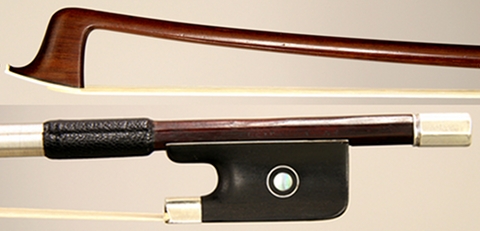EMILE AUGUSTE OUCHARD; THE BOWMAKER OF TWO WORLDS
"Ca, c'est la baguette... ca, c'est la husse...ca, c'est la mèche... et ca, c'est la porte!" In this way Emile Auguste Ouchard addressed to one of his detractors, joining "Gest à l'appui" to it , as Raffin writes. He may be the one who spread bowmaking in the world but inside he was French to the core !

Emile Auguste Ouchard
Emile Francois' son, was born in Mirecourt on 24 July 1900, and already at an early age, he starts becoming familiar with the job by "Cuniot-Hury", the same workshop where his father works. Both, after the death of Cuniot, he remains there working for the widow.
In 1922 his father decides to establish his own business and his son follows him, from that moment a long and not always fruitful collaboration starts between the two of them. Emile Francois is a great builder with much experience, but he probably makes the mistake of consiering his son as any other employee.
On September 2 of the same year he marries Andrée Marie Charlot Petot. The couple has four children, two sons Bernard and Jean-Claude who follow his father's job and two daughters, Colette and Anne-Marie.

Violin bow Emile Auguste Ouchard
From 1930 he begins a gradual path that will take him over the years to come off the paternal shapes to define and refine his style. Developing the idea of a friend luthier, who enjoyed dealing with bow making, Max Millant, he built a frog with a support very similar to that one by Hill, i.e. with a smaller octagonal , with the aim to minimize the clearance between stick and frog. He used this type of support until the early '50s.
In 1937 the differences between father and son become incurable and Emile Auguste decides to leave and opens a business by his own, during this time his bows are stamped "E.A. Ouchard fils". For some years he stays in Mirecourt, but soon this place becomes too small for both of them and He prefers to move to Paris.
He settles at 54, Rue de Rome , more or less halfway between the modern Raffin and Le Canu-Millant's workshops and he changes his brand into "E.A. Ouchard Paris". In this period his bows often have a number and a date.
In 1942, he wins the "Grand Prix" at the "Exposition des Artisians de Paris" and his business begin to go much better, this is his consecration.
Encouraged by more than one friend, including Yehudi Menuhin, he accepts, due to unspecified "family problems", the invitation of the luthier Lazare Rudie and in 1946 he moves to New York.
He works for a while in his workshop but maintaining an independent brand. The bows of this period are signed "Emile A. Ouchard New York." After him Jacques Francais, Bernard Millant and Etienne Vatelot will work in the same laboratory.
In 1948 he signed a yearly contract of $ 10,000 under the brand name Willam Lewis & Son, in Chicago, so he packs up once again to move to Illinois. Although the contract is meant to be as exclusive, Emile Auguste can not disappoint his old customers, and during his annual summer travels to Europe , he also sells by his own account.
Even if the agreeement was not closed (at the time of his death it was still valid), he inexplicably returns to New York in 1951 and starts working in a room that his friend Jacques Francais gives him.
In 1955 he travels to Brazil to buy and personally choose some wood for his bows.
In 1960, after nearly fourteen years in the United States, where as a good French he learned so less English as possible, he comes back to France and moves to Gan. In 1963 he marries once again and with his wife he moves to Vichy.
He continues to build even here and stamps his bows removing the words "New York" from the old American stamp. The work of this period is not comparable to the previous level, mainly due to the consequences following his first heart attack he had shortly after returning from the United States, therefore his manual skill is much reduced.
Emile Auguste Ouchard, the bow wanderer, hero of two worlds, dies in Gan on February 14, 1969.
The style

Violin bow Emile Auguste Ouchard
E.A., either for excess of self-criticism or inconstancy is never fully defined, he plays and dances in a never-common mixture of styles that affect the taste of the time, from by his father to Sartory, Lamy, Bazin, maintaining a perfection of execution and a really great lightness of intent. Amazing manual skilll and perfect technique: a professional of a very high level.
Even the frogs are very well done and shaped, even if sometimes they are too concrete. For example, as shown in the photo, the thickness of the ring is probably due to an excess of caution such as "the thicker it is the less it breaks" more German than French as a way of thinking, too high and it makes the throat very unbalanced downwards.
Also note that, in addition to what suggested him by his friend Millant, after 1935 he begins to fix the silver slide , which protects the octagon of the frog, with screws and not with nails, as used by the French school of the second '800.
So long
Paolo
|